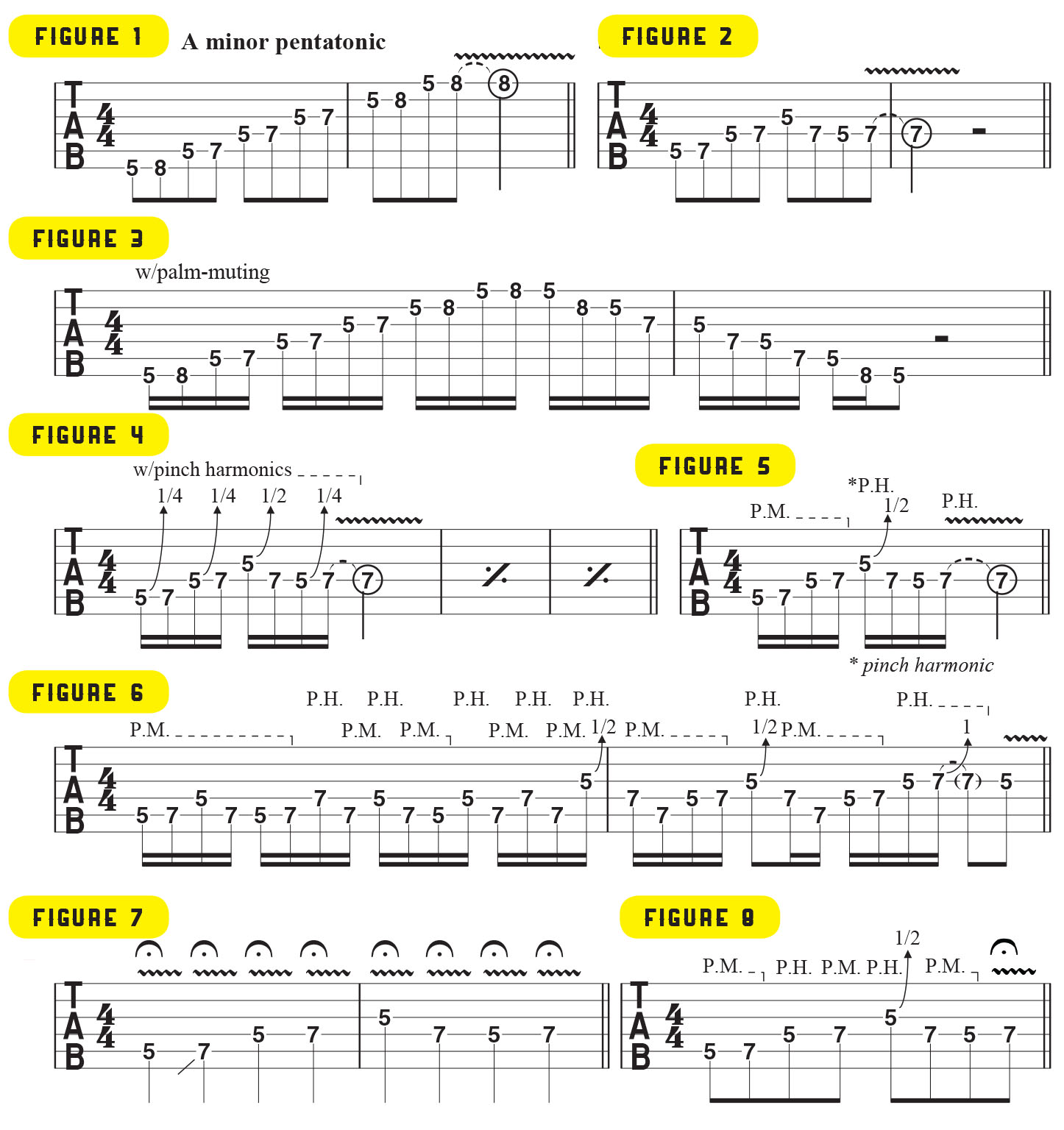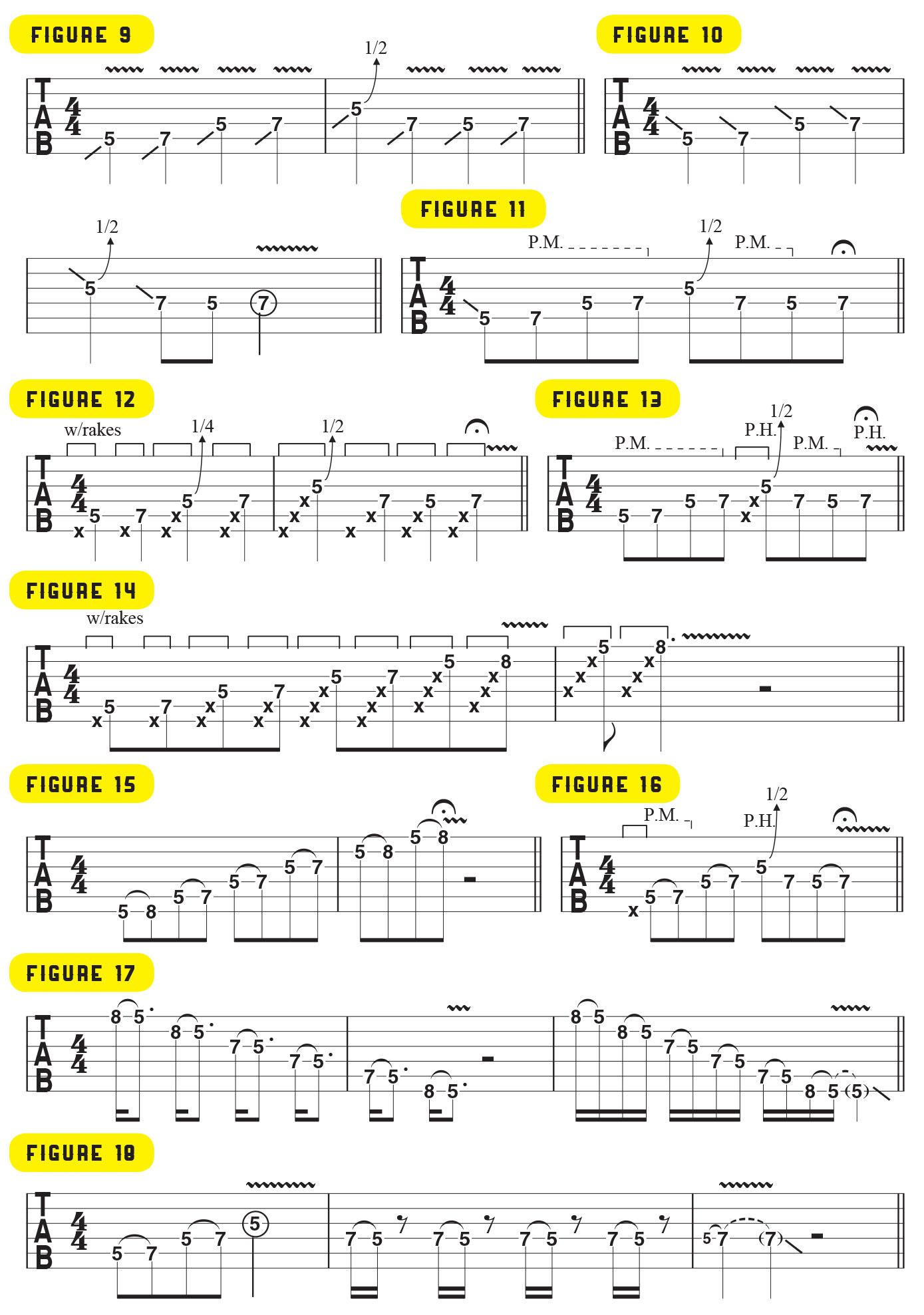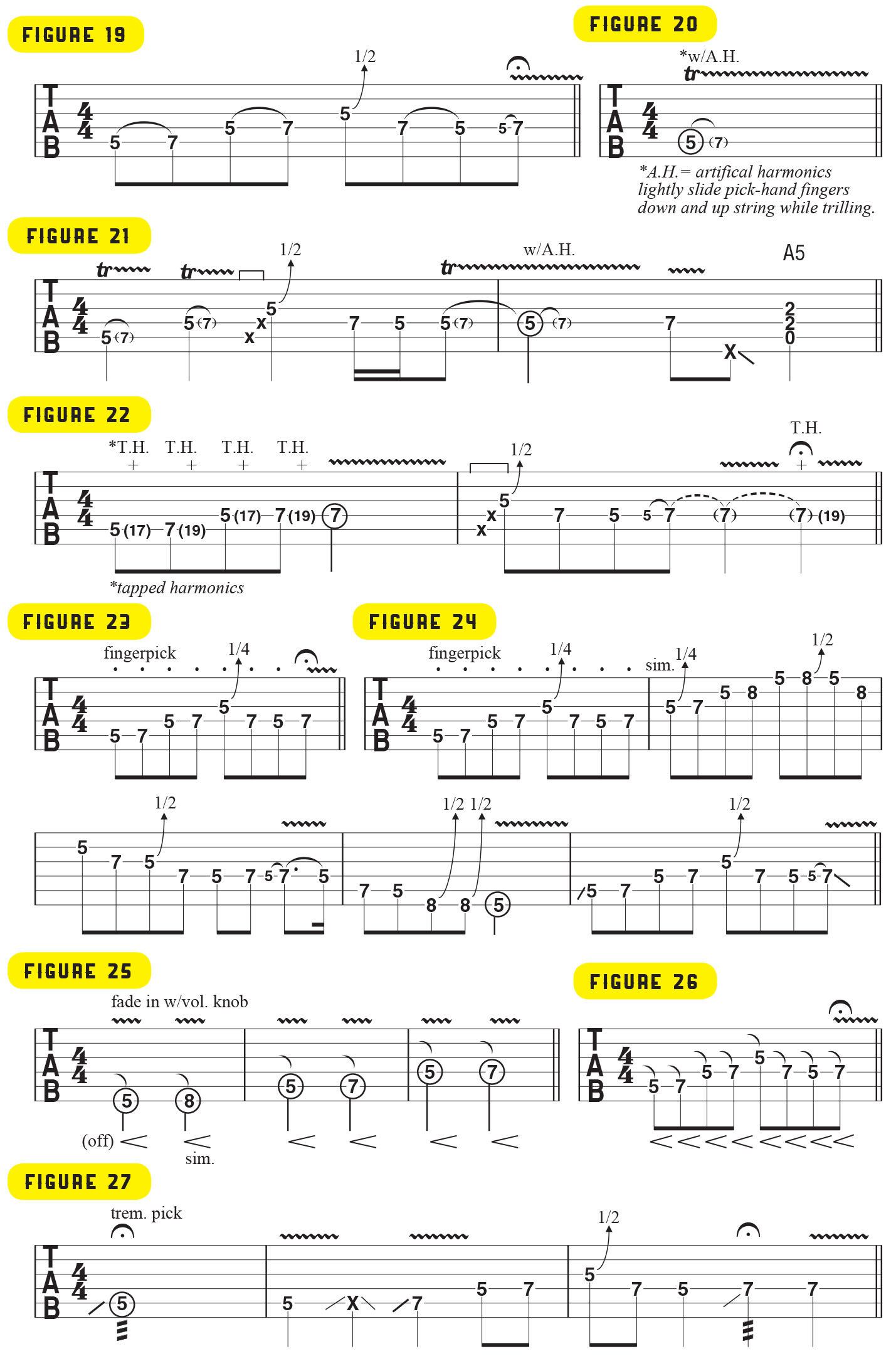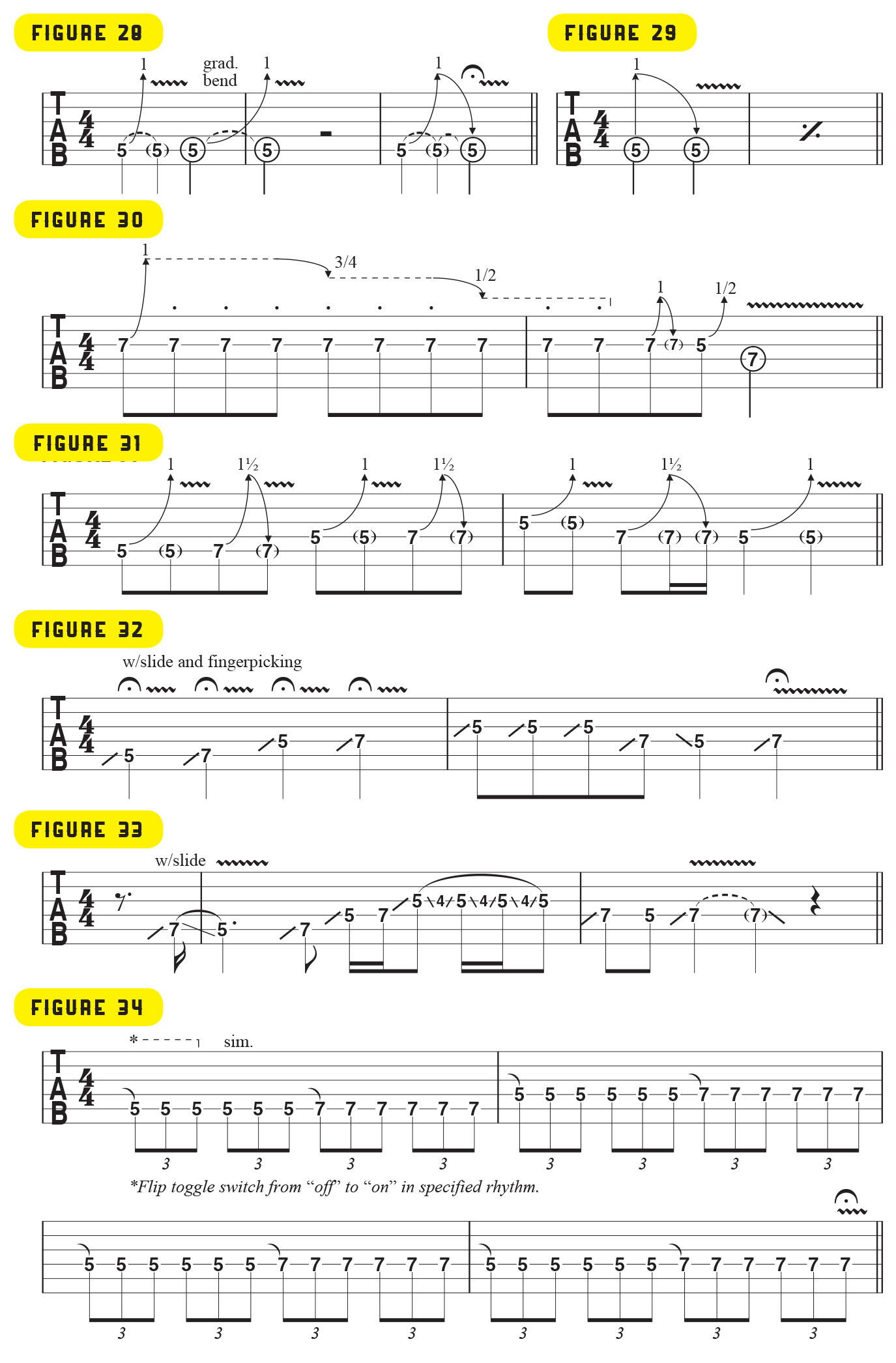How to Add "Color" to a Short Series of Notes Using 15 Different Techniques
Joel Hoekstra demonstrates 15 different ways to add “color” your notes and improve your riffs.

The first thing I often notice with a lot of beginner and intermediate rock guitar players whom I teach is that their articulation—the way in which they’re playing a note—is rather bland and lifeless.
Learning to employ various pick- and fret-hand techniques effectively can be the most important aspect of making what you play sound more expressive, musical and professional. And so I’ve put together this lesson with the beginner-to-intermediate player in mind. We’ll begin by taking a simple, ordinary phrase and explore various ways to make it come to life and sound cool and musical.
FIGURE 1 shows the standard fifth-position A minor pentatonic scale pattern that many rock guitarists learn early on, which serves as the foundation of rock soloing, as pioneered by our first guitar heroes of the Sixties and Seventies. We hear it in virtually every one of our favorite rock solos. You can go a long way using just the minor pentatonic scale if you explore some of the many different ways in which you can possibly articulate a phrase. So here are 15 different ways to “color” your notes.

1. PALM MUTING
For the purposes of demonstration, we’re going to use a consistent phrase that we’ll alter only by the way in which the notes are articulated. FIGURE 2 illustrates a simple eight-note phrase based on the A minor pentatonic scale. The first technique I’d like to demonstrate as a way to color your notes is to apply palm muting (P.M.). Lean the edge of your pick-hand palm across all of the strings next to the bridge saddles. Done correctly, this contact of flesh against the strings will deadens the sound of each note you pick while also making it sound more percussive. The goal is to get comfortable enough with this technique that you’re able to play across the entire scale and maintain an even volume and attack note to note, as shown in FIGURE 3.
2. PICK HARMONICS
Also known as a “pinch harmonic,” a pick harmonic (P.H.) is produced by touching a string with the edge of your pick-hand thumb as you pick a downstroke at one of several specific points along the string’s length, which are called nodes. Each node—you’ll need to “hunt and peck” for them—produces a different harmonic pitch when picked, or “pinched,” this way. When playing FIGURE 4, lean into the string for each note with the edge of your pick-hand thumb. Using your electric guitar’s bridge pickup and some distortion will accentuate harmonics.
Let’s now combine palm muting and pick harmonics: as shown in FIGURE 5, I begin the phrase with palm muting but then apply pick harmonics in the second half of the lick. FIGURE 6 offers a longer example of these two techniques in action.
3. FINGER VIBRATO
Finger Vibrato is without question one of the most important techniques for rock lead guitar playing. In FIGURE 7, I pick each note and, while it rings, I shake my entire hand up and down to produce a wide, even vibrato effect. In FIGURE 8, I incorporate palm-muting, pick harmonics and vibrato.
4. SLIDING UP TO A NOTE
Sliding up to a note from one or more frets below is a highly expressive way to decorate it. In FIGURE 9, I slide up to each note then add vibrato as the note rings.

5. SLIDING DOWN TO A NOTE
Sliding down to a note from one or more frets above creates its own distinct, expressive sound, as demonstrated in FIGURES 10 and 11.
6. RAKING
Dragging, or raking, the pick across adjacent strings, also known as sweep picking, is another highly expressive articulation technique. I’ll often rake my pick across strings that are lower than the one upon which a targeted fretted melody note is sounded, using both fret-hand muting and pick-hand palm muting on those raked strings to prevent them from producing anything more than a short, percussive “chuck” sound when picked. In FIGURE 12, you can see that one dead string (indicated by an “X” in the tab) is hit for the first two notes, but as the fretted notes move to higher strings, all of the lower strings are muted and sounded with a rake. In FIGURE 13, I combine all of the aforementioned techniques to achieve a very expressive-sounding phrase. A great practice approach is to play every note in the scale in this way, as demonstrated in FIGURE 14.
7. HAMMER-ONS
A hammer-on is a “soft” articulation of a note performed by quickly and firmly fretting a string with the tip of a fret-hand finger without picking it. FIGURE 15 illustrates our A minor pentatonic scale pattern sounded with hammer-ons on every other note. In FIGURE 16, all of the aforementioned techniques are incorporated into the articulation of the phrase.
8. PULL-OFFS
The pull-off is a more complex technique than the hammer-on. It basically involves lifting a fretting finger off of a string to sound a lower note on the same string without picking it again. But you additionally need to yank the string slightly sideways, in toward your palm, as you remove it from the string, in order to keep the string vibrating sufficiently and hear the next note at a good volume level. And unless you’re pulling off to an open string, you need to “pre-fret” the lower note to which you’re about to pull off. To play FIGURE 17 correctly, “snap” the pull-off finger across the string aggressively so that the second, lower note sounds as loudly as possible.
The only pull-off available to us in our repeated phrase is when we move from A on the fourth string to G, two frets lower. In FIGURE 18, I sound this pull-off repeatedly in order to emphasize this articulation technique. FIGURE 19 combines hammers and pulls in this stock phrase.

9. TRILLS
A trill is a continuously alternating sequence of hammer-ons and pull-offs. One of the ultimate cliché rock lead licks is to trill with the fret hand while lightly sliding the side of an outstretched pick-hand finger down the length of the string, which results in a series of shifting artificial harmonics, as demonstrated in FIGURE 20. Eddie Van Halen and Randy Rhoads were pioneers of this technique, and it sounds awesome! In FIGURE 21, I begin with a normal trill, followed by notes articulated with rakes and vibratos, and then I bring in the “sliding harmonics” trick from the previous example.
10. ARTIFICIAL HARMONICS
The technique I demonstrate here is also known as tapped harmonics, because each note is sounded by quickly tapping onto the string exactly 12 frets above the fretted note, which will produce an artificial harmonic that sounds an octave higher. Another approach is to pick each note conventionally, followed by a tapped harmonic. In FIGURE 22, I tap directly onto the fret to sound each harmonic in bar 1, followed by straight picking and ending with the tap that follows the pick strike.
11. FINGERPICKING
When one fingerpicks a string, as opposed to striking it with a plectrum, different sounds are available, depending on the specific manner in which this is done. In FIGURE 23, I use a finger to aggressively pick each note, plucking and snapping the string against the fretboard and producing slight harmonics as a result. I like using my pick hand’s thumb and index and middle fingers to do this. FIGURE 24 offers a longer example of this technique.
12. VOLUME SWELLS
Here’s a technique well suited for the beginning of a song, when the sound of the guitar is first introduced in an arrangement. With the instrument’s volume control turned all the way down, set a fret-hand finger down on a note and then turn up the volume, so that the note fades in. This technique, demonstrated in FIGURE 25, produces the ultimate soft articulation, akin to that of a bowed violin, and is often referred to as a volume swell. FIGURE 26 shows our stock phrase performed with this technique.
13. TREMOLO PICKING
Tremolo picking is alternate picking (down, up, down, up, etc.) one note repeatedly and as quickly as possible. As shown in FIGURE 27, I begin by sliding into and tremolo picking the first note, and I conclude the phrase by tremolo picking the second to last note as well.
14. STRING BENDING
When it comes to rock guitar soloing, string bending is king! Practice sounding a note and then bend that note up to the next higher note in the lick or scale, as demonstrated in FIGURE 28. Here, I apply vibrato at the conclusion of each bend, whether the bend is performed quickly or slowly.

Another great bending technique is pre-bending, also known as ghost bending, wherein a string is bent before it is picked, and then the bend is released, as shown in FIGURE 29. Another cool technique is to bend a note and then gradually release the bend while repeatedly picking the string, as illustrated in FIGURE 30. Also, practice bending into each note of the lick (see FIGURE 31).
15. USING A SLIDE
Playing slide guitar is a great way to “color” your notes, as it enables one to smoothly glide into them from above or below and adorn them with a highly vocal-like vibrato. I use a glass slide, worn on my fret-hand pinkie, and sound each note by lightly placing the slide on the string directly over a given fret. When playing FIGURES 32 and 33, be sure to deaden every string except for the one you’re playing on. I fingerpick most of the notes with my index finger while blocking the other strings with the other fingers.
BONUS! THE TOGGLE SWITCH TRICK
Another cool rock guitar technique is to set the volume of one pickup all the way down and that of another all the way up, then use your pickup selector switch to toggle the switch from the “off” position to “on” as you simultaneously hammer-on a note, as demonstrated in FIGURE 34. This “trick” works best with a two-pickup configuration, such as that of a Les Paul–style guitar.
Get The Pick Newsletter
All the latest guitar news, interviews, lessons, reviews, deals and more, direct to your inbox!
"Upgrading from your entry-level acoustic opens the door to an entirely new world of tonewoods, body shapes, and brands": 6 signs it's time to upgrade from your first acoustic guitar
"I'm past my prime": 5 common excuses for not learning the guitar – and 5 body and mind-boosting reasons you should









![Joe Bonamassa [left] wears a deep blue suit and polka-dotted shirt and plays his green refin Strat; the late Irish blues legend Rory Gallagher [right] screams and inflicts some punishment on his heavily worn number one Stratocaster.](https://cdn.mos.cms.futurecdn.net/cw28h7UBcTVfTLs7p7eiLe.jpg)
